
As they have begun to ascend into NBA championship contention, the Memphis Grizzlies have been called many things: immature, dirty, and chaotic. While their style of play is diametrically opposed to the Grit and Grind era of the early 2010s, there are similar signifiers between both teams’ perceived identities.
We wanted to give flowers to the last bastion of half-court banging the Grit and Grind team embodied by comparing it to the modern version of the franchise, which enters Saturday night with the No. 2 seed in the Western Conference behind the Denver Nuggets. The teams with which they had classic playoff battles — the Los Angeles Clippers and Oklahoma City Thunder — were early avatars of where the NBA was trending.
Marc Gasol being traded to the Toronto Raptors in 2019, only to win a championship immediately, was the meteorite that wiped out the 2010s Grizzlies’ style of play from the modern NBA. Ironically, the style of play that emerged best embodies the modern Grizzlies team, led by up-and-coming superstar point guard Ja Morant, who is a one-man transition wrecking ball. He is possessed with elite athleticism and hops, adjectives that don’t describe a single player on
the Grit and Grind squad, which was filled with Earth-bound and chiseled two-way players who
weren’t afraid to bang down low.
We’ve matched up each team to contrast their strengths and weaknesses and see which team would come out on top if they played. The 2014-15 Memphis Grizzles are considered the best version of that era. So we will be pitting that season’s squad against this season’s team.
The two couldn’t be more different. The average age of the 2014 team was 30.5 years old. The average age of today’s squad? 23.9. And that’s just the start. Let’s blow the whistle and see what would happen when these two opposing forces collide.
| STATS | 2013-14 GRIZZLIES | 2022-23 GRIZZLIES |
| PPG | 96.1 (held teams to 94.6) | 116.1 (held teams to 112.2) |
| 3-PT % | 353% / opponents .355% (30th/11th) | .345% / opponents .357% (24th/12th) |
| 2-PT % | .487% / opponents .484% (11th/11th) | .539% / opponents .513% (19th/2nd) |
| O-Rating | 106.3 (15th) | 113.9 (18th) |
| D-Rating | 104.6 (7th) | 110.1 (2nd) |
| Net Rating | +1.7 (14th) | +3.8 (5th) |
| Pace | 89.9 (30th) | 101.6 (3rd) |
Point Guard: Mike Conley Jr. vs. Ja Morant
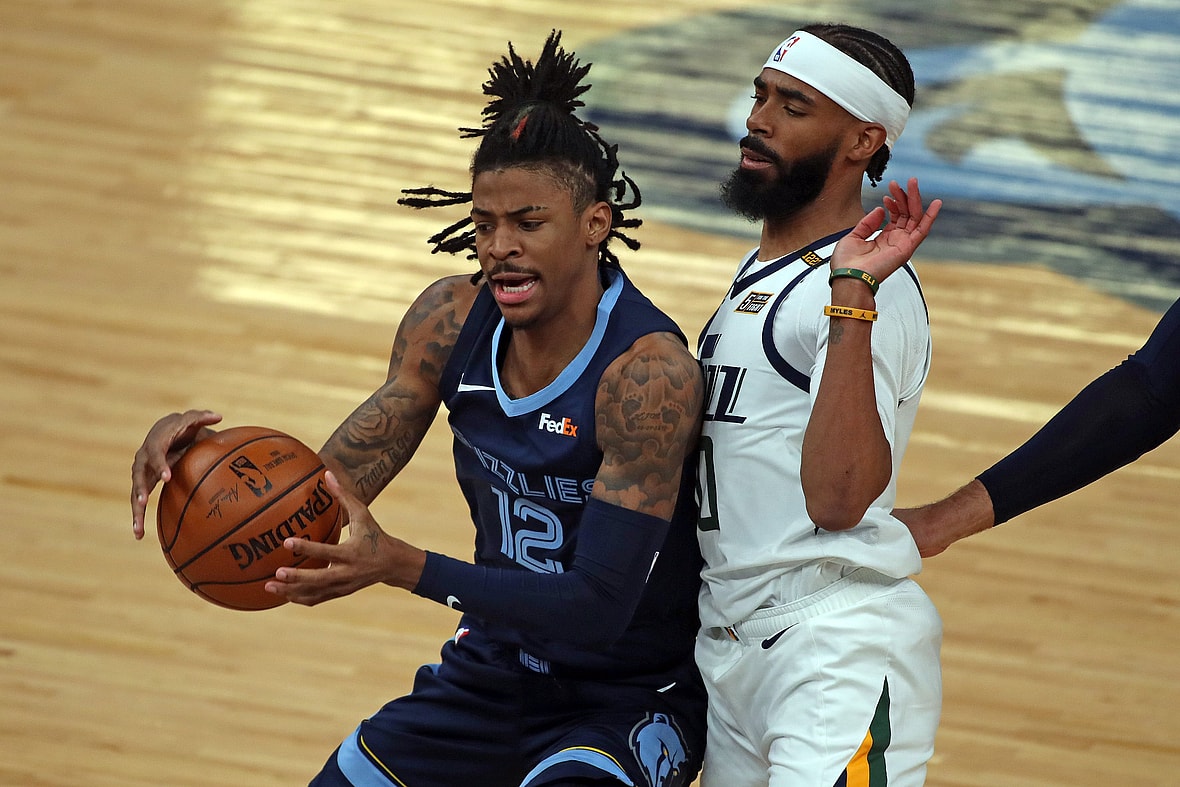
Of the Grit and Grind era, only the 55-27 Memphis Grizzlies of 2014-15 had an offensive and defensive
rating better than the league average. It was the best balance of both sides of the ball for this
team, and much of that was due to the two-way play of Mike Conley Jr., who averaged 15.9 points
and 7.9 assists that season.
Conley was a sturdy, stocky, and serious guard. He was one of the best guard defenders of his era, even though he only stood 6-foot-1. We know Conley today, now with the Minnesota Timberwolves, to be a veteran who has developed a 3-ball. But during his days in Memphis, he was widely considered the most underrated player in the NBA, as he did not make an All-Star team during his career with the Grizz.
As solid and underrated as Conley was, this is the most lopsided positional battle we have. As
Ja Morant is a top-three point guard after Steph Curry and Shai Gilgeous-Alexander. Morant’s
combination of high IQ, dribble penetration, and efficiency at the basket makes him the most
dangerous driving threat from the perimeter in the game.
Morant would have difficulty guarding Conley, as the elder statesman was one of the most efficient post-up guards at the time, and Conley would make Morant work in face-up situations. Still, Morant brings a level of athleticism Conley would have only seen from Russell Westbrook and Derrick Rose. Winner: Ja Morant
Shooting Guard: Courtney Lee vs. Desmond Bane
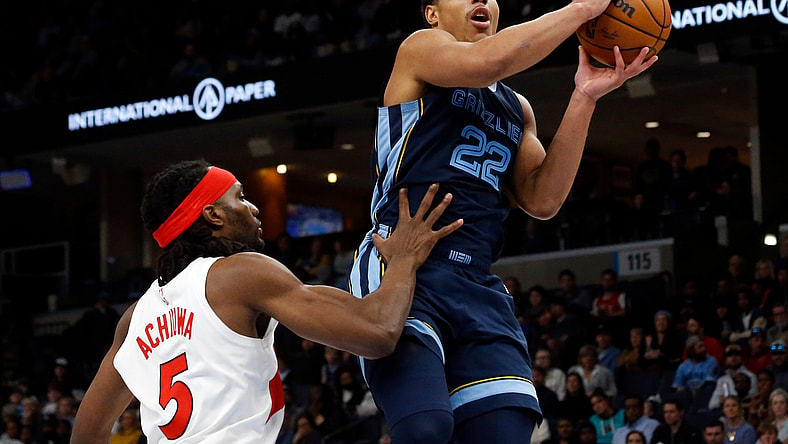
The 2014 Memphis Grizzlies were first in made two-point baskets, and 29th in made threes — a stat that could regulate them to Draft Lottery status had they played in today’s NBA. The only two players in the main rotation who hit threes above 34 percent were Mike Miller (45.9 percent), Conley (36.1 percent), and starting shooting guard Courtney Lee (34.5 percent), with Lee taking the second most threes a game at 2.9 per.
Lee came to the Grizz from the Orland Magic, where he was a key contributor to their 2009 Finals run. Lee provided spacing and perimeter defense and was considered one of the better 3-and-D prototypes of his era, even though the percentages and attempts would be toward the bottom of the league for guards today.
This is one example of a player, in this case, Desmond Bane, being better than his matchup in
every facet of the game. Bane and Lee were the same height (6-5), but Bane just looked bigger
and stronger. But he is a way better three-point shooter at 42.7 percent and a superior athlete. Bane also has a higher ceiling than Lee, who averaged a career-high 12 points to Bane’s current 21.5 points he is averaging this season.
It’s only Bane’s third year in the league, and he has the potential to be a one to two-time All-Star, a feat Lee never reached as a journeyman role player. Winner: Demond Bane
Small Forward: Tayshaun Prince vs. Dillon Brooks
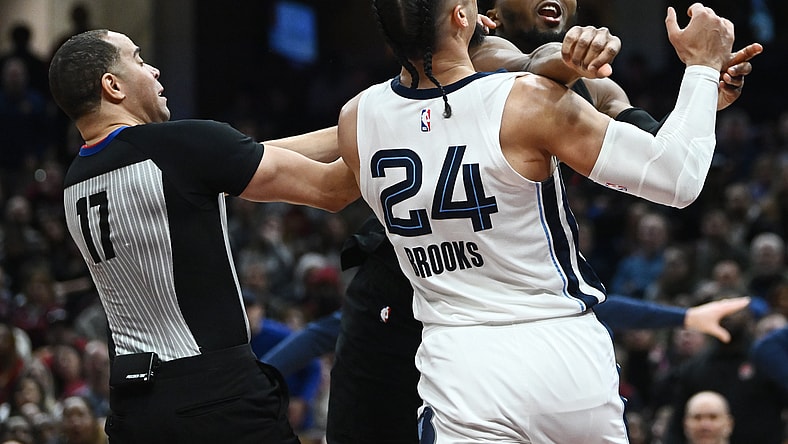
Tayshaun Prince came to the Grizzlies in a three-team trade in the middle of the season, leaving behind a long career as the Detroit Pistons starting small forward and replacing longtime small forward Rudy Gay.
Gay’s finesse on-ball game never fully jelled with the Grit and Grind era. Although 33 and at the
tail end of his career, Prince meshed better with the defense-first identity. Prince shot an (up to
that point) career-worst 29 percent from long distance that season, averaging only 8.8 ppg, the lowest since his rookie season. While he contributed to the team’s defensive system, he was no longer the defensive stopper he was in Detroit once he arrived in Memphis.
Dillon Brooks is one of the most hated players in the league. The immaturity, arrogance, and dirty stigma the team has developed on social media and from casual fans is most centered around the play of Brooks. He is a very physical player and certainly crosses the line in defending opponents. But he has developed this reputation for a reason. This is unfortunate, as he is a very good all-around basketball player, averaging around 15 points and one a steal a game.
This one is fairly close, with both players playing integral roles with the teams and sacrificing greater statistical averages to fill a need defensively. Winner: Dillion Brooks
Power Forward: Zach Randolph vs. Jaren Jackson Jr.
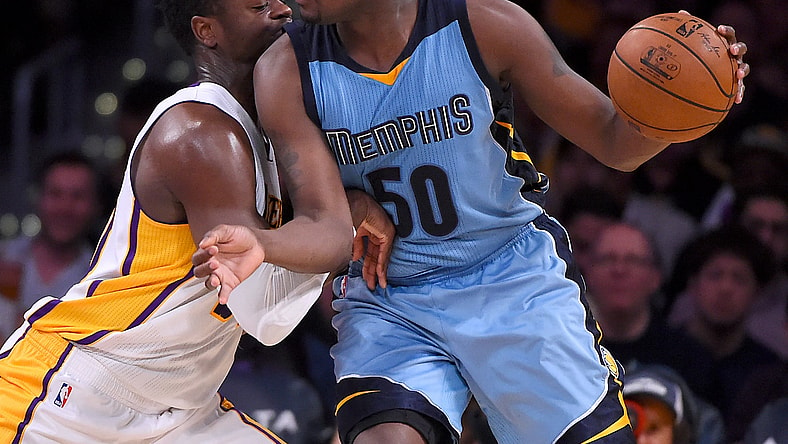
When you think of the best power forwards during the 2010s, Zach Randolph, or Z-Bo as
Memphis fans enduringly knew him, was top five. He was a double-double machine, averaging
such nine times in his career and five times with the Memphis Grizzlies.
In 2014, he was the team’s leading scorer at 17.4 ppg and was one of the most unstoppable post-presences in the NBA. Because of the pace and space evolution of the game, and NBA fans’ generally short attention spans, Randolph tends to be less remembered than some of his contemporaries as a force on both sides of the ball. But after bouncing around in the league, he found a home in Memphis with a fan base who appreciated his blue-collar approach to scoring and defending.
Jaren Jackson Jr. hasn’t developed into the star big man many Grizzlies fans hoped he would when he was drafted No. 4 overall in 2018. But he has matured into a stout defensive force, and he’s the odds-on favorite to win Defensive Player of the Year honors this season. He’s averaging an efficient 17 points on .566 eFG% and an astounding 3.3 blocks per game. Jackson anchors the Grizzlies’ elite defense, and his ability to finally stay healthy this season has solidified what the team can be on both ends. Winner: Zach Randolph
Center: Marc Gasol vs. Steven Adams
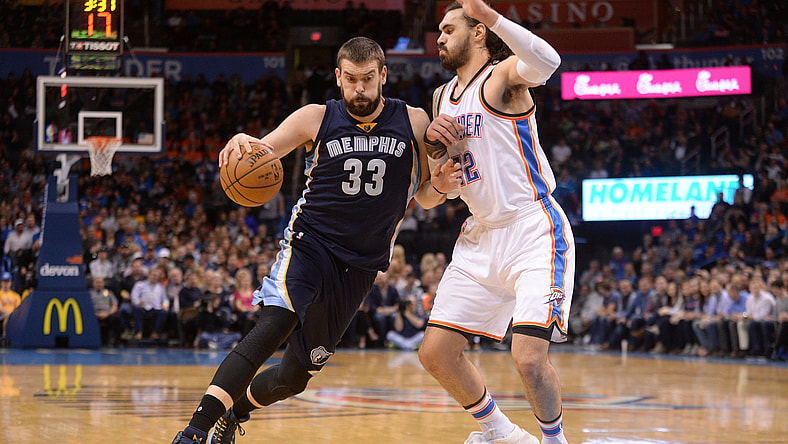
When Pau Gasol was traded from the Memphis Grizzlies to the Los Angeles Lakers in 2007, it was seen by many as a major fleece. But one of the throw-in assets to the trade was the draft rights to Pau’s younger brother, Marc.
The younger Gasol would fill his brother’s role as the best player on the team and a fan favorite by playing the opposite of his brother. Where Pau was finesse and even-tempered, Marc was rough, gritty, and played with fierce abandon. Marc led the Memphis Grizzlies further than his brother did, as Pau never escaped the first round of the playoffs with the franchise. Marc led the team to the Western Conference Finals in 2013, behind his 14.6 ppg and 7.2 rpg. Paired with Randolph in the frontcourt, the two forged the best frontcourt in the NBA at the time and, defensively, made life hell for anyone who tried to drive on them.
Like the Pau trade, when Memphis traded skilled big man Jonas Valančiūnas to New Orleans in 2021 for Steven Adams, many thought Memphis lost the trade. Adams is a relic of the past, better suited for the Grit and Grind era Grizzlies. He is a burly, offensive rebounding machine but
regulated to lobs and two-footed dunks on offense.
Adams has provided the Grizzlies with the best offensive rebounding hands in the league and a dependable veteran presence. His experience with many battles during his time with the Thunder make him the calming force of a talented but inexperienced team. Winner: Marc Gasol
Sixth Man: Tony Allen vs. Tyus Jones
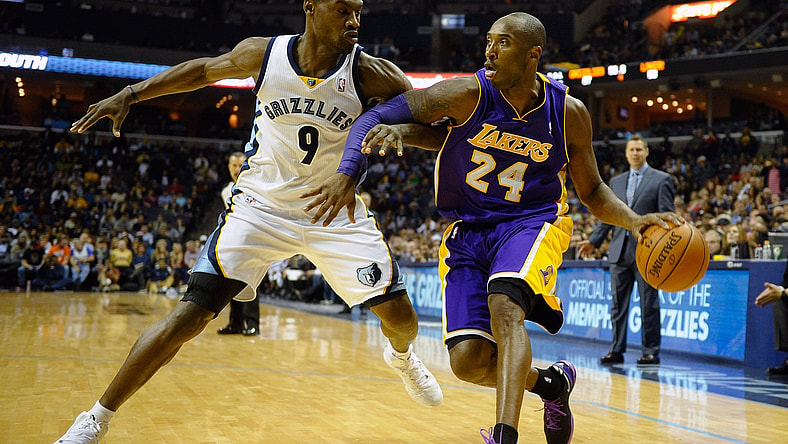
While Z-Bo and Gasol were the stars, and Conley was the brains behind the operation, Tony
Allen was the heart and soul of this team. Allen was one of the greatest perimeter defenders of his
generation. He was recognized by every star of his era, especially Kobe Bryant, for being able to
guard them physically and mentally. Allen never backed down from the toughest assignment and regularly came up with clutch shots, rebounds, and charges to seal wins for his team.
One of the reasons the Memphis Grizzlies have been able to sustain wins and momentum when Morant
has gone down with injuries is that Tyus Jones is one of the best backup guards in the league.
He is chipping in a cool 9.8 ppg and 4.5 apg this season in just 23 minutes per game while hitting 37 percent from 3.
Jones provides a broader frame and defensive chops when he subs for Morant. Not many teams with star point guards can sit their main dude without sacrificing leads. Jones is the stopgap for the Grizz, bringing a high IQ approach and selfless determination to his role. Winner: Tony Allen
Which team was better? The Verdict
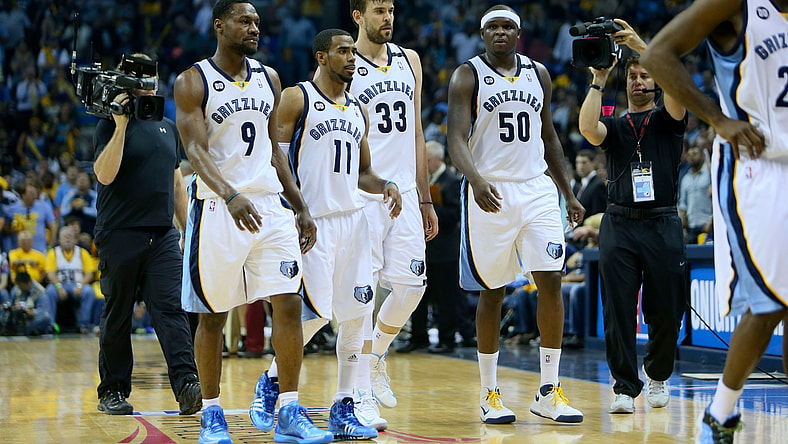
Both teams were elite in their eras. The Grit and Grind Grizzlies were the first great team in
franchise history, and Randolph and Marc Gasol, along with Morant, are the three best players
they’ve ever had. But if they were matched up with each other and forced to fight for supremacy
in pace and style, the defensive ability of Grit and Grind would pull it out.
That team had a player at every position who was a lockdown defender. There were no holes in the starting five or with Allen coming off the bench. They could smother you, and they did, against the best super teams of that era: the Thunder, LA Clippers, and Miami Heat. While they lack the collective athleticism of this year’s Memphis Grizzlies, they would slow Morant, and certainly the role players, through intelligence, footwork, and continuity.
By 2014 the core of that team was battle-tested through multiple playoff battles. Morant might get his, but the rest of the 2023 team would be severely limited in their impact and forced to play the older version’s methodical, half-court slug-fest.
Winner: 2013-14 Grit and Grind Grizzlies
Lee Escobedo covers the NBA for Sportsnaut. You can follow him on Twitter at @_leeescobedo